In the US, ecommerce is expanding wildingly. Really, people buy everything— food, tools, even dog costumes—online (really, I investigated). Though each big player—Amazon, Walmart, eBay—has its own strategies—big companies are controlling the game. eBay’s like that friend who has everything; Walmart’s about discounts that make you double-check the price; Amazon’s like that friend. This is like a treasure hunt! Still, if you want to compete, viewing these sites is insufficient. Plerdy allows you see what’s working on your site, measure clicks, and stop wondering what users want. Knowing these channels helps companies keep ahead, not only for entertainment value. So, all set to delve in? Let’s roll.
Overview of the US Ecommerce Market in 2025
US ecommerce market projected for 2025? It is growing rapidly. We are discussing income exceeding $1.2 trillion—yes, a lot of zeros here. Americans buy online as if it were a daily habit. Online buying is just… whether it’s for groceries from Walmart, the newest iPhone from Apple, or handmade goods on Etsy. life as it is now.
Big names predominate. Alone, Amazon grabs 37.6% of the market share. How one site can be everywhere is crazy. Walmart trails with 6.4%, working hard with fast pickups and groceries delivery. Target, Costco, and Best Buy—each vying for a piece of the ecommerce pie—then follow. And believe me; that pie is really large.
How is this expansion being driven? a fusion of tech and convenience. Mobile purchasing is hot; almost 65% of all ecommerce sales originate from phones. Imagine yourself waiting for coffee, reading through your phone, and suddenly you just bought new shoes. Consistent occurrence.
Still, shoppers remain finicky. Thanks, Amazon Prime for setting the benchmark; they want speedy shipping, seamless checkout, and accurate product information. Oh, and reviews. People live in accordance with them. None of reviews? No deal. That’s basic.
Here’s what’s trending in 2025:
- Personalized recommendations that feel like mind-reading.
- Sustainability is huge—brands brag about eco-friendly packaging.
- Voice shopping—yeah, people ask Alexa to buy stuff for them.
- AR features let you see how that sofa looks in your living room before you click “buy.”
There is no stopping down of this market. Running a site allows tools like Plerdy to demonstrate user navigation of your pages, so you stop guessing and start converting. To be honest, in a market this rapid guessing is a luxury you cannot afford.
Criteria for Ranking the Top Ecommerce Sites
How then can you find the US ecommerce sites that are truly killing it? It goes beyond mere popularity. Some things reveal which ecommerce sites lead the US market to follow.
First of importance is visitor traffic. Not one visit. There is no sales. uncomplicated Amazon receives over two billion visits a month—yes, that is insane! About 540 million are pulled in by eBay; Walmart not far behind. There is increased likelihood of purchases when more individuals visit a site. More money and more eyeballs. Makes sense, then.
Having traffic, however, does not indicate the rolling in money of a site. Revenue and profitability thus become rather important. Just in the last quarter, Amazon generated almost $152 billion—very impressive! Walmart’s ecommerce Drawing in roughly 670 billion annually. Not pennies. Although a lot of visitors are great, what good is it if people are not making purchases?
Still, money is only one thing. Customer experience counts quite a lot. People want quick service, seamless checkouts, and fast deliveries. Target and Best Buy among US sites provide curbside pickup since nobody wants to wait days for a phone charger. Negative past experience Consumers jump to another online retailer.
Indeed, never forget the range of goods and services. Amazon markets anything from kitchen sinks to novels. Etsy? Your go-to ecommerce site for antique discoveries and handcrafted presents is Walmart here? Foods, clothing, technology—you name it, it’s there.
Looking at all this—traffic, sales, customer satisfaction, and product diversity—you truly see which US ecommerce sites control the show. Should you have an ecommerce site, Plerdy‘s capabilities can assist in understanding visitor behavior on your sites. There is no more conjecture now. Just actual information meant to improve the performance of your site. Sounds practical, right?
| Ecommerce Site | Monthly Visits | Revenue (2024) | Key Features | Unique Selling Points |
|---|---|---|---|---|
| Amazon | 2.08 billion | $152 billion (Q4) | Amazon Prime, AWS, Wide Product Range | Fast delivery, AI-driven personalization, massive inventory |
| eBay | 543.8 million | $10.2 billion | Auctions, Small Seller Platform | Popular for second-hand goods, collector’s marketplace |
| Walmart | 492.7 million | $670 billion | Walmart+, Quick Delivery, Extensive Store Network | Hybrid online-offline shopping, competitive pricing |
| Etsy | 276.2 million | $2.1 billion | Handmade & Vintage Goods, Small Business Focus | Eco-friendly options, personalized products |
| Target | 217.4 million | $100 billion | Curbside Pickup, Exclusive Brands | Strong loyalty program (Target Circle), quick local delivery |
| Home Depot | 191 million | $158 billion | DIY Products, Tool Rentals, Repair Services | Home improvement focus, how-to guides for customers |
| Costco | 122 million | $242 billion | Membership Model, Bulk Purchases | Low prices, trusted Kirkland Signature products |
| Best Buy | 155.9 million | $42 billion | Electronics Sales, Geek Squad Services | Fast pickup options, tech support for all customers |
| Wayfair | 122.3 million | $14.8 billion | Furniture & Home Goods, AR Visual Tools | Virtual room planners, tailored shopping experience |
| Apple | 150.3 million | $400 billion | Direct Device Sales, Apple Store Integration | Loyal customer base, global product launches |
Detailed Profiles of the Top 10 Ecommerce Sites
1. Amazon

Amazon here? Oh, the king of US ecommerce sites is here. This massive online retailer generates more traffic than most nations have people with an amazing 2.08 billion visitors every month! And financial situation? Sure, it is rolling in. Amazon made almost $152 billion alone in Q4 2024. Un sane, right?
What qualifies Amazon as such a powerhouse? You do have Amazon Prime, free delivery, movies, music,… People find it like an all-in-one deal they cannot refuse. Then there is AWS (Amazon Web Services), which generates a sizable portion of their earnings. Their ecommerce system markets everything—tech devices, books, groceries—you name it.
Still, it goes beyond mere variety. Amazon is really adept at utilizing artificial intelligence to show you things you might want before you even realize it. and delivery? Quick does not even cover it. In some regions same-day shipping is available! That is level of convenience right now. Since let’s be honest, Amazon’s user experience sets the benchmark, thus tools like Plerdy can show you how people utilize your pages—should your ecommerce site dream of competing.
2. eBay
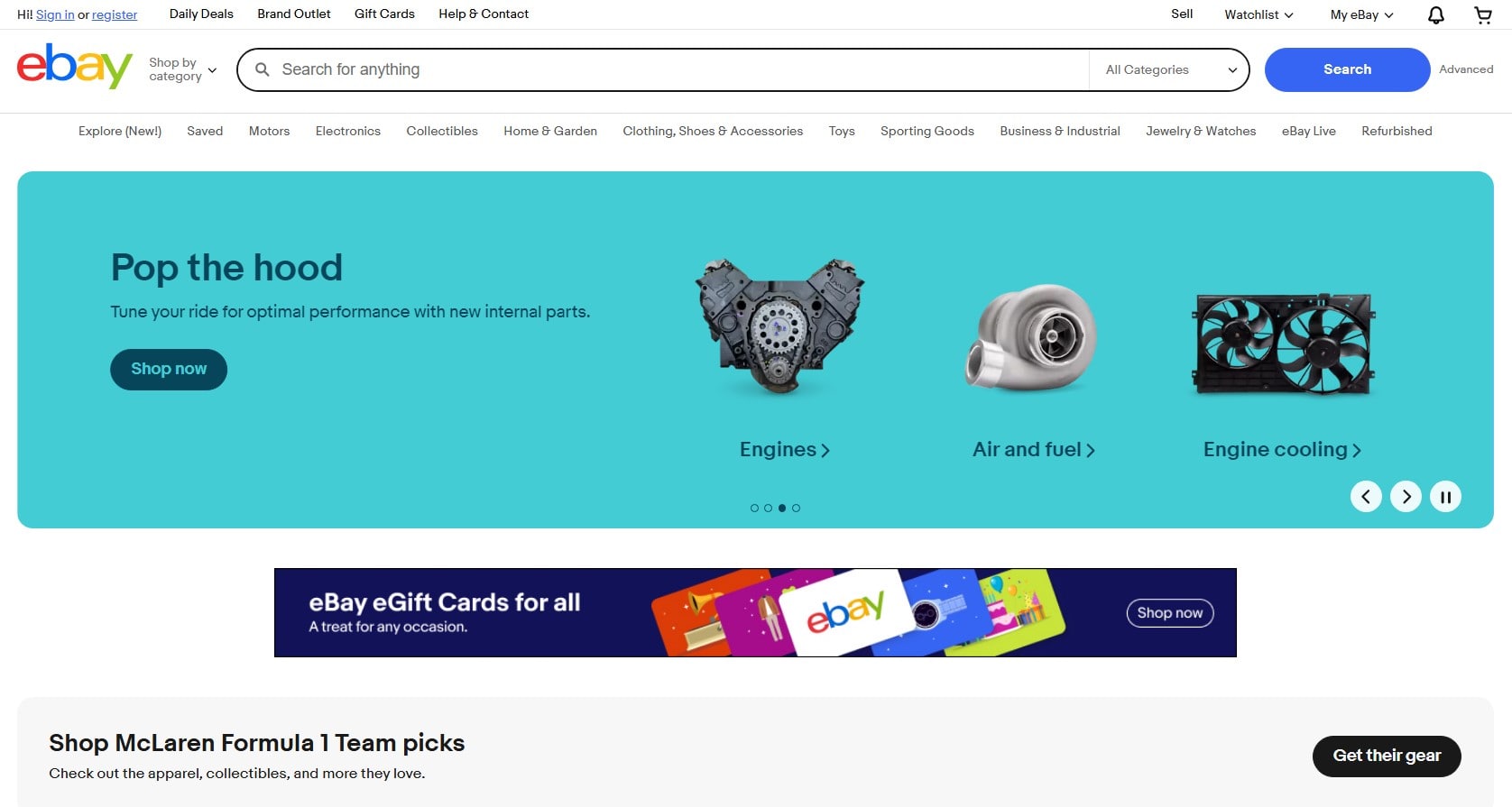
Since 1995, eBay has been playing in the ecommerce scene; guess what? It’s still really robust. With around 543.8 million visits a month, this ecommerce site is still a US go-to destination. Though not at Amazon-level wealth, eBay’s revenue-wise in 2024 came in at $10.2 billion—pretty amazing.
Why then do people return constantly? Just simple auctions! Bargaining on items and landing a bargain gives one some excitement. eBay is also ideal for collectors or rare finders—old vinyl records, vintage toys, you name it. And for little vendors? eBay is really helpful. From handcrafted goods to old phones, you can sell almost anything.
One very noteworthy aspect is eBay’s community feel. Reviews are relied upon by buyers and sellers; thus, trust keeps the site humming. Understanding user behavior is essential if you run an ecommerce site and wish for that kind of loyalty—and yes, Plerdy can help with that. When you know, why should one guess?
3. Walmart
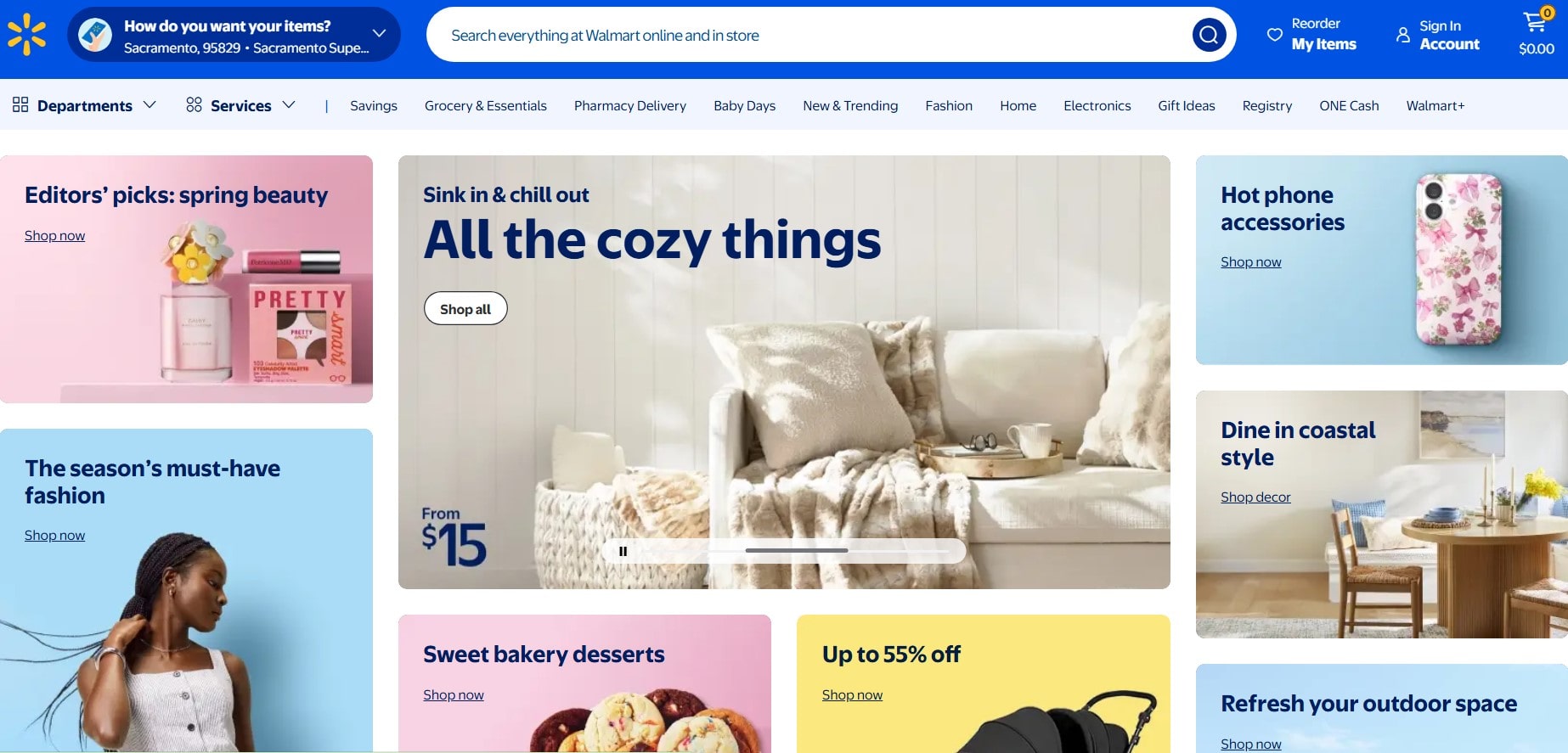
In US ecommerce, Walmart is a beast. With around 492.7 million visits a month, it is no more only a food store. Their ecommerce generates significant volume and the money? Oh, it’s huge. Walmart’s income in 2024 came out to be shockingly $670 billions. That will be sufficient to purchase. practically anything, well.
Why is their ecommerce game so robust? Big deal Walmart+ offers are free shipping, fuel discounts, and even grocery delivery. When one is not forced to wait for fundamental needs, people enjoy it. Walmart’s vast network of physical stores also provides hybrid strength most ecommerce businesses cannot match. Order online and pick it up at the store; it’s rather handy.
Let us now also consider speed. Many US towns have these with same-day delivery. Imagine buying food and having them right at your door before your movie begins. Strange, right? Using tools like Plerdy will help you monitor what’s working on your pages if you run an ecommerce site and find ways to compete. You have to keep up if Walmart is raising the benchmark this high.
4. Etsy
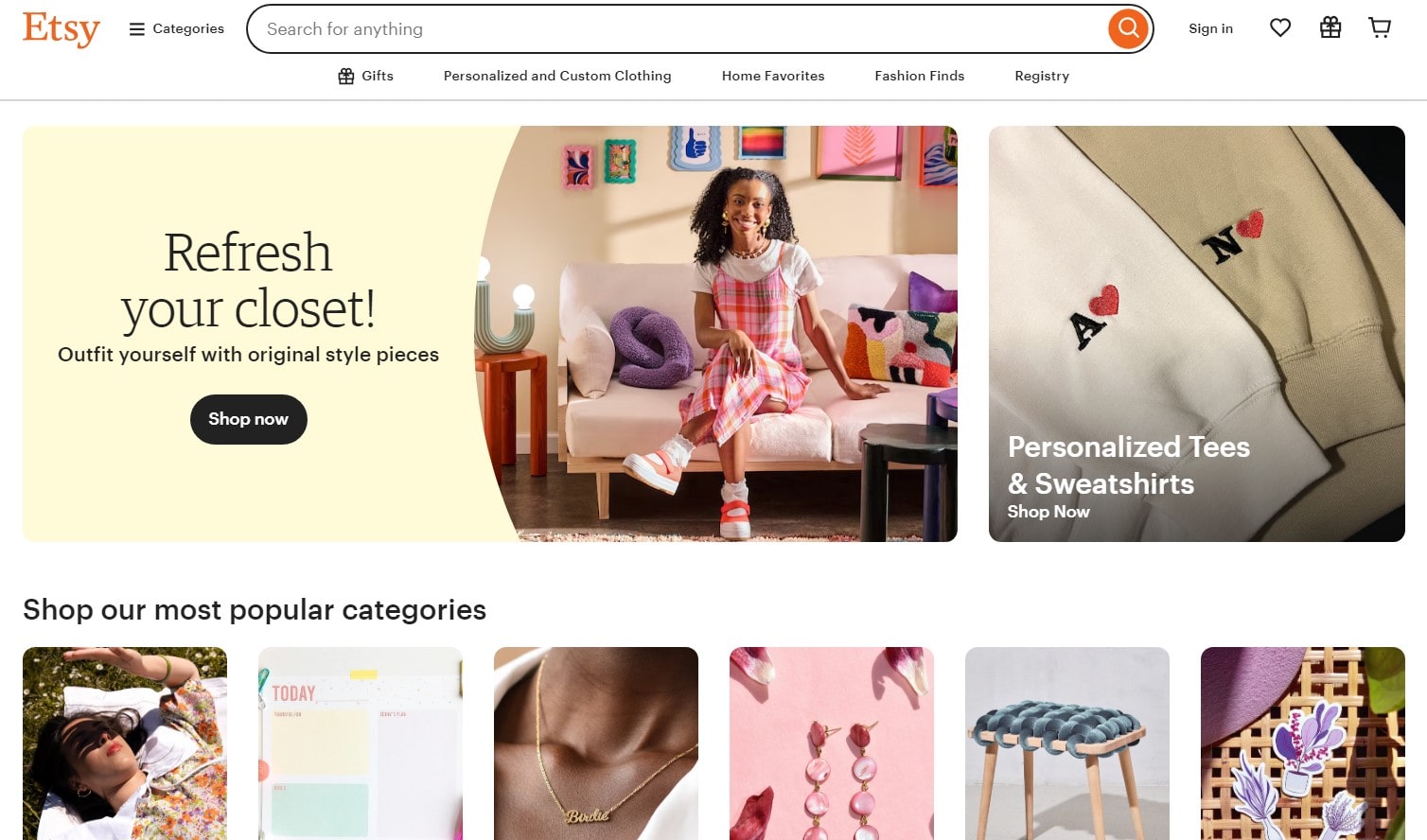
For Americans looking for something unique, Etsy is the preferred online retailer. You know, odd mugs, old posters, and handcrafted jewelry. People clearly enjoy unusual discoveries based on 276.2 million visits annually and $2.1 billion in revenue by 2024.
What’s interesting about Etsy? It is designed for independent producers and small companies. Scarves are being knit by your neighbour? Etsy is where one finds them sold. And customers? They enjoy helping out neighborhood musicians. Etsy also emphasizes environmentalism; ecological packaging and carbon-neutral delivery are major selling propositions.
Mass manufacture is not what Etsy is about. It concerns narratives. You are purchasing from a kitchen table business, not just a candle. That ties? Unbreakable. Analyzing user activity using Plerdy will help you understand how people interact if you run an ecommerce site and wish for similar community vibe. People linger when a site feels personal, and Etsy’s evidence of that is clear.
5. Target

The goal is that ecommerce site in the US where you search for toothpaste ends up with a cart loaded with items you never intended to purchase. Given 217.4 million visits every month, it is evident people cannot resist. Target brought in almost $100 billion in income in 2024—yes, they are not simply peddling pretty pillows and snacks.
What distinguishes this ecommerce site? Two words: curb-side pickup. You purchase online, swing by, and someone throws your things in the car; there is no need to get from your seat. handy when in pajama mode. Target also has those unique brands—Good & Gather and Cat & Jack—that you cannot find anywhere else and draw customers in.
And if you chase deals, Target Circle loyalty program is gold. People like that extra touch—discounts, customized offers, even birthday goodies. Managing your own online retail store? Examining Target’s balance of consumer benefits and ease (plus tools like Plerdy tracking visitor behavior) could inspire solutions. To be really honest—everyone enjoys a seamless buying experience including an unexpected discount.
6. Home Depot
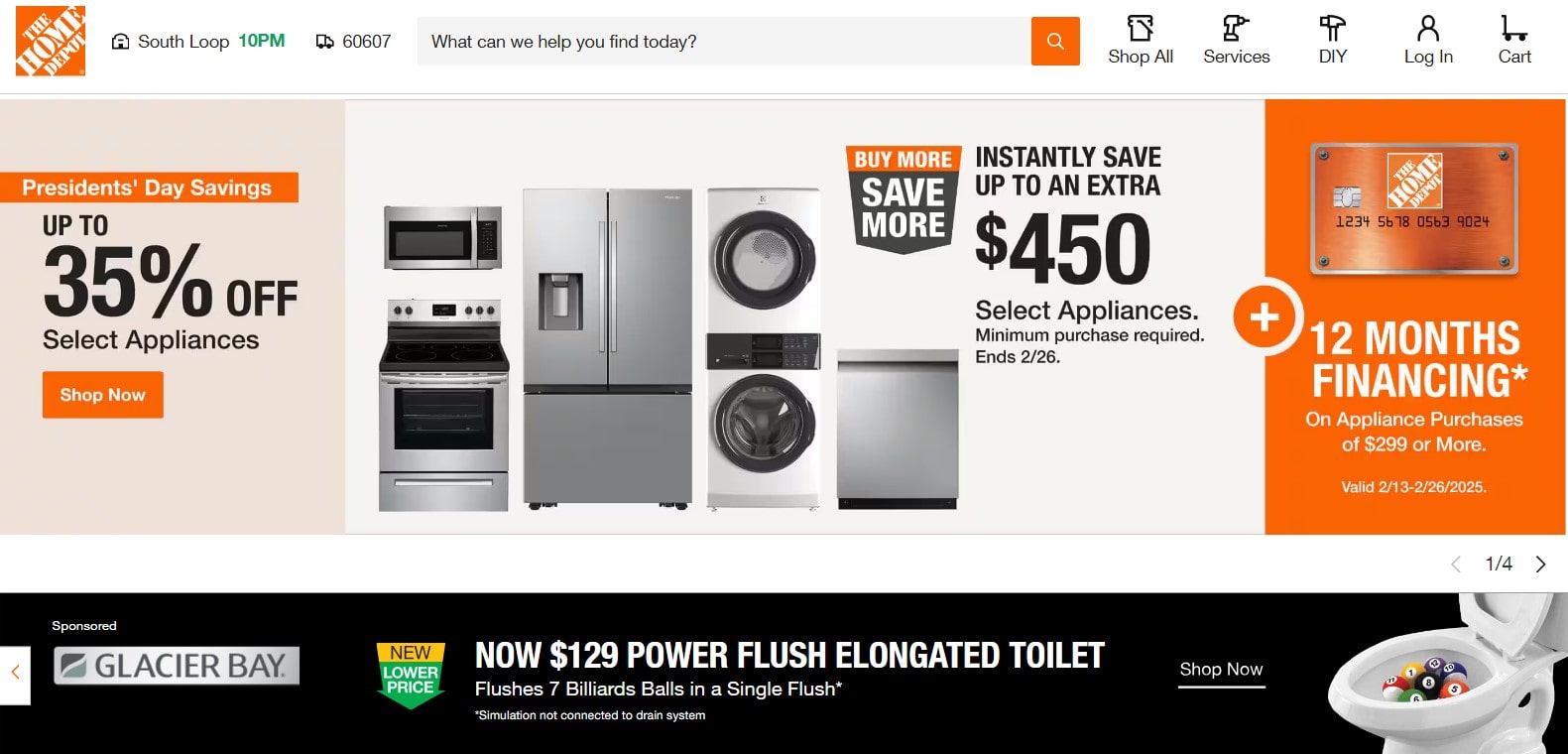
Home Depot is an ecommerce behemoth in the US besides being for extreme do-it-yourselfers. This site shows people truly love fixing things—or at least purchasing the tools to try—with 191 million visits a month and a staggering $158 billion in income for 2024.
Online shopping here is like entering a massive warehouse without the hefty carts. You need a drill? Painter? Outdoor furniture for a patio All of it is present. The best thing about it is Their ecommerce provides do-it-yourself instructions that spare you from disaster projects; nobody wants to wind up with crooked shelves.
And if you’re not ready to buy, you could rent tools rather than handing money to purchase one item you will use once. Smart shopping is what you do. Furthermore, the site is straightforward to use with really useful filters. Tracking visitor clicks with Plerdy will let you see what works if you have your own ecommerce site and wonder how to make navigation user-friendly. Because nobody stays around a confused site—even if you are offering power tools.
7. Costco
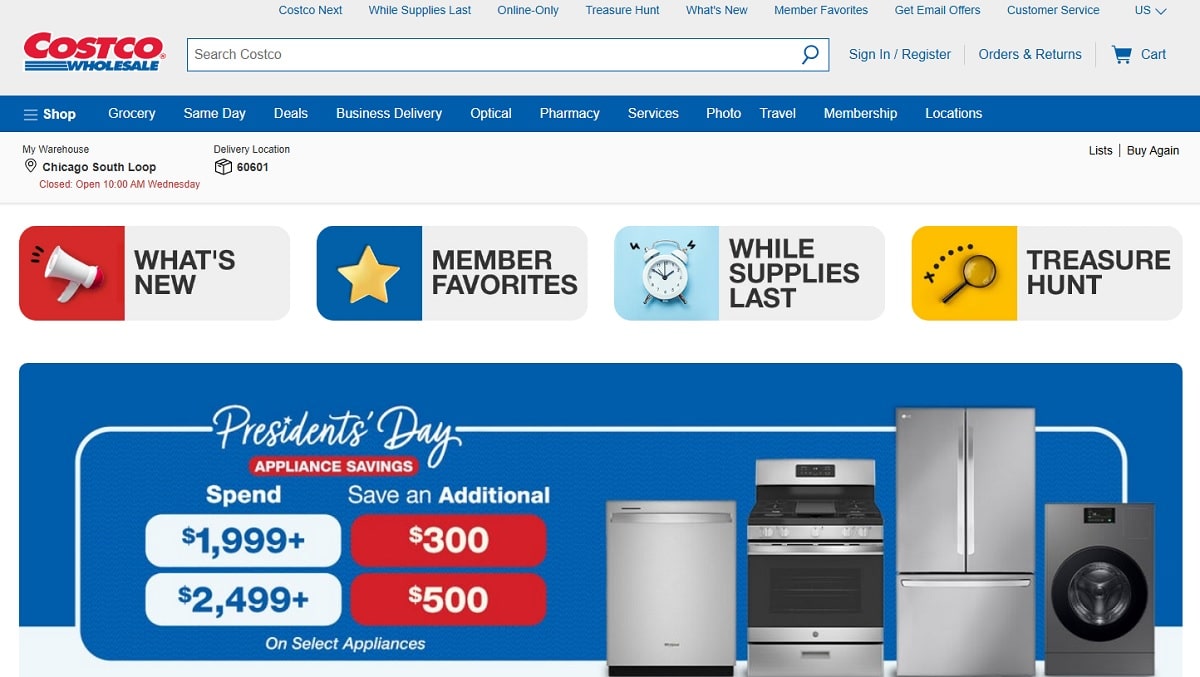
Costco is a whole feeling, not only another ecommerce site available in the US. People clearly enjoy big offers and bulk purchases based on 122 million visits each month and $242 billion in sales by 2024. You get twenty rather than one pack of gum. Though it saves money, feels like getting ready for the end of the world!
Costco operates under a membership concept, which at first seems strange. Pay to buy at the store? Still, individuals enjoy it since, particularly when making large purchases, those discounts up quickly. There then is Costco’s private label, Kirkland Signature. It’s good, not only reasonably priced. Their coffee, wine, even batteries run under well-known names. Customers trust it.
The Costco ecommerce site also makes shopping quite easy. Order, yes, truly, large amounts of appliances, groceries, or even vacation packages. Looking into how Costco strikes pricing, trust, and convenience will be well worth it if you are building your own ecommerce site. Would like to observe your visitors’ behavior? Plerdy facilitates this; no guesswork is required.
8. Best Buy
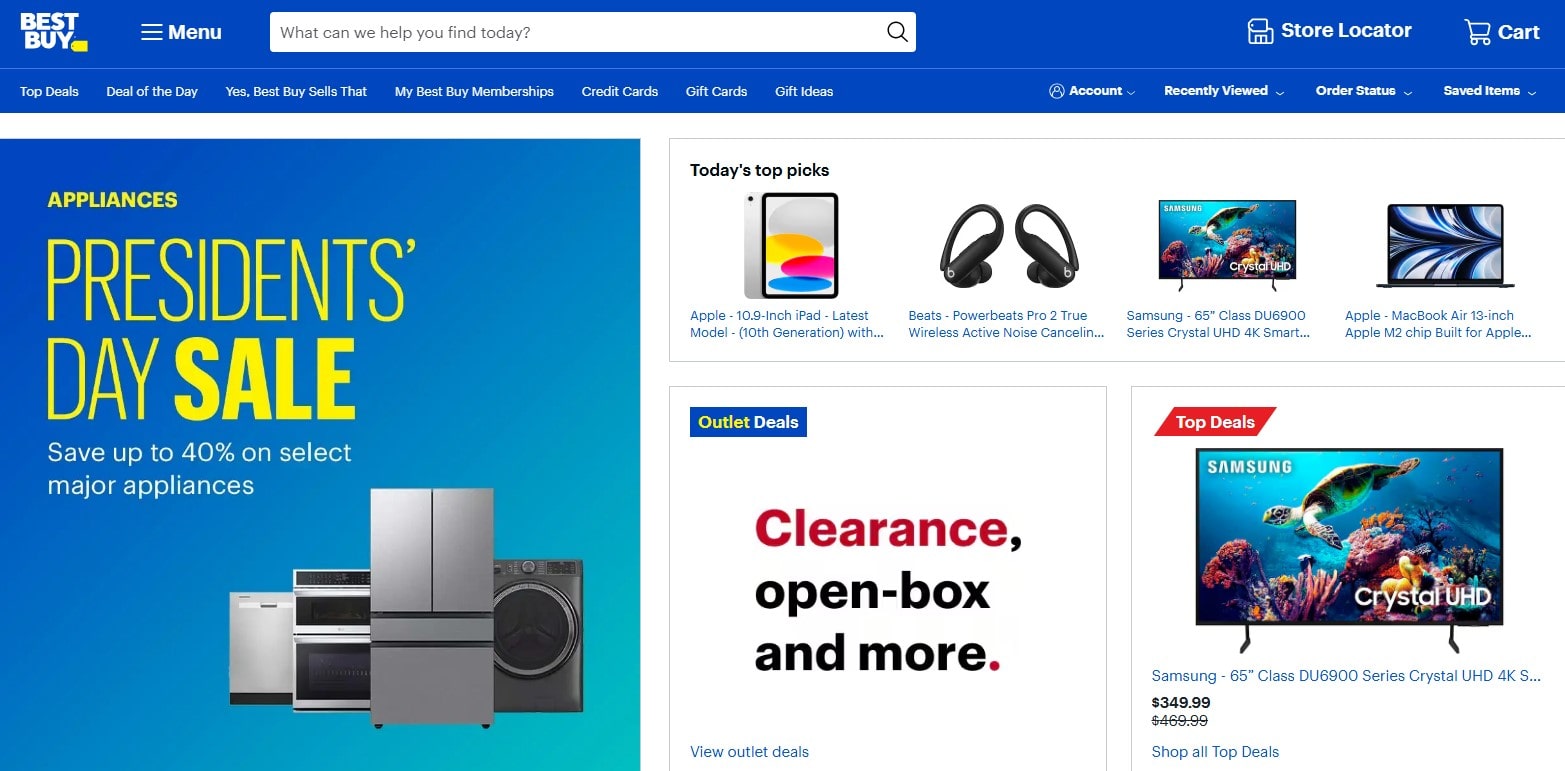
Tech aficionados feel at ease on the US ecommerce site Best Buy. From laptops to smart fridges reminding you when you run out of milk, customers clearly trust them for electronics—from 155.9 million visits per month to $42 billion in revenue for 2024.
Their weapon of secret importance is Geek Crew. Not only a great name—this service protects people against technological disasters. acquired a new TV but know nothing about configuring it? You are covered by Geek Squad. That’s a big issue when rivals merely wave goodbye and sell goods.
Shopping on the ecommerce portal of Best Buy goes easily. Sometimes in under an hour, you may order online and pick up in-store. They also provide quick shipping for times when you could not wait days for your new headphones. If you run an ecommerce site, it would be wise to learn how Best Buy balances consumer service with technology sales. And you can learn where users drop off or what clicks using Plerdy; they say data never lies.
9. Wayfair

The US online retailer Wayfair is essentially furniture paradise. With 122.3 million visits a month and $14.8 billion in income for 2024, this is where people go when they wish to give their houses a new look without getting off the sofa. Looking for a brand-new sofa? Wayfair offers thousands of choices. < Are you looking for unusual wall art? Indeed, they do have it too.
How unique is this ecommerce platform? Virtual space. Before you buy, you can examine how furniture suits your environment; no more wondering whether that brilliant yellow chair would go with your rug. Their individual recommendations also are quite accurate. You look at one coffee table and then your feed looks like a well chosen fantasy room.
The easy-to-use Wayfair site attracts consumers back often. You understand how important that is if you own an ecommerce. Plerdy and other tools can help you see how visitors navigate as you will be in problems if your customers cannot locate the checkout button.
10. Apple

Apple is an ecommerce behemoth not just a tech corporation. Fans rush to grab the newest iPhone or AirPods on their US ecommerce site, which boasts 150.3 million visits monthly and an astounding $400 billion in revenue for 2024. And let’s be honest: people wait in virtual lines like it’s a rock concert rather than just shopping.
Why is Apple’s ecommerce game the best? Straight forward product sales via the Apple Store. There are no middlemen; simply elegant tools and accessories right to you. Their site’s design is simple but sharp, akin to classic Apple. It’s seamless, easy to use, and causes you to want to click “buy” without second thought.
And the loyalty of the consumers? Level of excellence. Global product introductions cause extreme surges in internet traffic. Studying how Apple transforms launches into events is absolutely gold if you are building an ecommerce site. Using Plerdy allows you to observe how your guests interact and perhaps even catch a bit of Apple magic.
Comparative Analysis of the Top Platforms
Market Share Distribution
Though Amazon rules with a huge 37.6% market share, the US ecommerce business in 2025 is a hostile battleground. That is an empire rather than only dominance. People go there for everything: food, books, tech devices—you name it. Their range of products is appalling. Along with their product line, Amazon Prime and AWS providing the backbone of many companies also help to explain their supremacy.
But exclude Walmart from your count. Having a strong 6.4% market share, it is climbing. Their tenacity? reasonably priced daily needs like groceries. For those last-minute dinner necessities, Walmart’s ecommerce site excels by combining online buying with its physical locations. For customers rushing, their curbside pickup changes everything.
Different ecommerce systems serve different purposes. Walmart governs in-store pick-ups and supermarket sales; Amazon concentrates on a worldwide reach and unlimited categories. Both sites provide excellent answers for US consumers based on their search for something.
Customer Experience and Services
As it is, nobody enjoys slow delivery. Amazon understands it and provides Prime’s two-day (sometimes same-day) shipping. People are returning constantly from it. Their site and app are flawless; add to cart, check out, done. Not bothered. Offering free shipping, fuel discounts, and quick delivery, Walmart’s catching up with Walmart+, Though not as showy as Amazon, it gets the job done.
Reversals Amazon makes it practically too simple; occasionally you may not even need to mail things back. Walmart also has a handy return policy, particularly in cases where you live close to their outlets. Their ecommerce site enables you begin returns online and complete them in-person.
Programs for loyalty play a major part. While Walmart+ concentrates on savings at the pump and shopping benefits, Amazon Prime offers streaming services and exclusive bargains. Though in distinct ways, each target client loyalty. Customers on US ecommerce sites seek speed and convenience, and these sites provide such in great abundance.
Ecommerce Trends Driving Success in 2025
American ecommerce is accelerating, hence if you blink you will miss something very important. mobile trade? It is exploding! Right today, over 72% of ecommerce purchases take place on cellphones. People simply like riding the metro or waiting for coffee by browsing sites and shopping on-demand. Apps from behemoths like Walmart and Amazon are making click and purchase too simple. Given this, mobile commerce is consuming the market rather naturally.
Then there is the overall movement in sustainability. American consumers are not only searching for low-cost offers now. They lean toward environmentally beneficial decisions. Businesses including Etsy and Patagonia are stepping up with carbon-neutral shipping and green packaging. It’s excellent for business as well as for the earth. Consumers feel comfortable supporting brands that show concern.
And let us now discuss customisation. Behind several ecommerce sites is artificial intelligence running the show. Ever noticed how you visit Wayfair, and boom? Every other site shows the same chair? Creepy or cool? Either way, recommendations generated by artificial intelligence increase sales really dramatically. Products that seem tailored particularly for a customer inspire increased expenditure by consumers.
2025 has more than just shopping ahead. It’s about experience. Ecommerce combining speed, eco-friendly design, and personalizing elements? In the US, those are the ones earning hearts as well as wallets.
Challenges Faced by Leading Ecommerce Sites
Although running a top US ecommerce site sounds great, it’s not like walking in a park. Data privacy: Serious headache. Consumers want their data safe as cyberattacks are becoming more common. After earlier hacks, companies like Target and Best Buy have strengthened security; nonetheless, shoppers still worry every time they visit “checkout.”
There is then the insane rivalry. Every day new platforms open up and specialty stores are grabbing pieces of the market. Not even titans like Amazon can relax. Consumers today look at substitutes with distinctive goods or better prices.
And don’t start on environmental issues. Fast delivery is fantastic; yet, what is the carbon footprint? Not quite as much. Plus, logistics and gasoline prices are exploding. Businesses like Walmart balance going green with maintaining fast delivery times. Juggling consumer needs with environmentally sustainable actions? Way more difficult than it seems.
Future Outlook for the US Ecommerce Market
What direction US ecommerce is headed? Get ready since things are getting wilder. By 2026, analysts project income of $1.5 trillion. mobile buying? Still scorched. Buying items on your phone will be much more seamless with quicker 5G and smarter apps.
The influence of technology is becoming really wild. AR allows you “try” furniture in your room before making a Wayfair purchase. Artificial intelligence, or AI It personalizes every ecommerce site and generates shockingly accurate product recommendations. Consumers now days demand tailored experience.
Consumer behavior is also changing too. People want faster delivery and greener choices. While consumers search for green offers, companies like Apple are doubling down on carbon-neutral targets.
One thing is rather obvious: ecommerce in the US won’t slow down. Platforms combining speed, customisation, and green ideas will rule. Those slowing down? They will fade into digital dust.
In Essence, Conclusion
Not only are major US ecommerce firms Amazon, Walmart, and eBay selling, but they also have more in mind. People are shopping differently these days. Their rivalry drives fresh ideas including speedier delivery, sweet loyalty programs, and tailored purchasing. More options and better offers help shoppers win large. Who does not enjoy a customized product recommendation that just gets you or free shipping?
Sitting stationary is not a choice available to companies. Fast changing ecommerce is seeing trends in mobile purchasing and sustainability gathering momentum. Adapting makes one survive. Ignoring missing opportunities Any business cannot afford that risk. Hence, leap forward and keep ahead!
